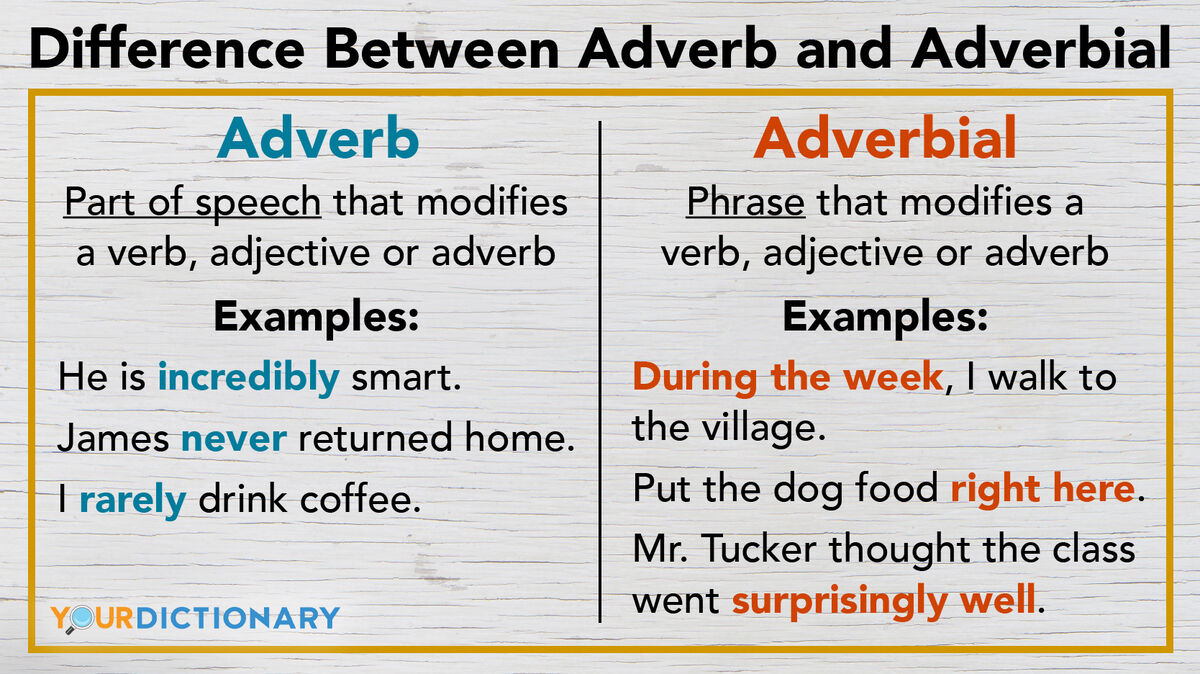
Is there any difference between an adverb and an adverbial? Adverbs modify verbs, adjectives and other adverbs. Meanwhile, adverbials act like adverbs to modify a verb or a clause. Adverbials can consist of a single word or an entire phrase. Keep reading for a closer look at adverbs vs. adverbials, and for several examples of the differences.
Adverbs: One-Word Modifiers
Adverbs are one-word modifiers that describe more about other parts of speech. They are considered one of the main word classes, along with nouns, adjectives and verbs. While many adverbs end in -ly, other adverbs have different endings. There are five main categories of adverbs, grouped by their function.
- adverbs of time - describe when something happens (such as "yesterday" or "later")
- adverbs of place - describe where something happens (such as "everywhere" or "here")
- adverbs of manner - describe how something happens (such as "quickly" or "nervously")
- adverbs of frequency - describe how often something happens (such as "often" or "rarely")
- adverbs of degree - describe the degree to which something happens (such as "very" or "almost")
Examples of Adverbs in a Sentence
It's helpful to see adverbs grouped by their modifiers. They're most commonly used with verbs, as in these examples:
- He talks quickly. (“quickly” modifies the verb “talks”)
- She wrote slowly. (“slowly” modifies the verb “wrote”)
- James never returned home. (“never” modifies the verb “returned”)
However, you can also use adverbs to modify adjectives:
- He is incredibly smart. (“incredibly” modifies the adjective “smart”)
- She was terribly rude. (“terribly” modifies the adjective “rude")
- The landscape is impossibly green. (“impossibly” modifies the adjective "green")
And finally, adverbs can modify other adverbs:
- Sam runs very quickly. (“very” modifies the adverb “quickly”)
- He visits rather seldomly. (“rather” modifies the adverb “solemnly”)
- She greets them somewhat kindly. (“somewhat” modifies the adverb “kindly”)
Technically, adverbs are single-word adverbials. All adverbs are adverbials, but not all adverbials are adverbs.
Adverbials: Phrases That Act Like Adverbs
Adverbials, also known as adverb phrases, function like adverbs to modify verbs, adjectives and adverbs. Adverbials are typically infinitive phrases or prepositional phrases that are functioning as adverbs, but they can also be adverbs with intensifiers (such as very or really).
Adverbials function to explain when, where, how, or why something happens. They can also address frequency or degree.
- adverbials of time - describe when something happens (such as "in the morning" or "later in the year")
- adverbials of place - describe where something happens (such as "all around me" or "right here")
- adverbials of manner - describe how something happens (such as "with an angry tone" or "like a baby chick")
- adverbials of reason - describe why something happens (such as "to prepare for the trip" or "for the best possible result")
- adverbials of frequency - describe how often something happens (such as "every other Tuesday" or "once or twice a year")
- adverbials of degree - describe how something happens (such as "very suddenly" or "almost silently")
Examples of Adverbials in a Sentence
Using adverbials in your sentences can make your writing more interesting to the reader. Examples of adverbials in a sentence include:
- During the week, I walk to the village.
Olivia plays basketball as well as her sister.
Put the dog food right here.
- The bride was really quite lovely.
- Mr. Tucker thought the class went surprisingly well.
- Let's go to the party to meet some new people.
- After an hour, Melissa decided to take a break from studying.
- They sang loudly as they decorated the tree.
Notice that in the last sentence, "loudly" is an adverb that is not part of the adverbial phrase. It modifies the verb "sang," as does the phrase "as they decorated the tree," but it is a separate part of the sentence.
Examples of Adverb vs. Adverbial
Now that you know the basic differences between adverbs and adverbials, see if you can tell which is which in these example sentences. You can also use them as a guide to make your own writing more vivid and engaging.
- No modifier - Susanna sings.
- Adverb - Susanna sings beautifully.
- Adverbial - Susanna sings like a beautiful bird.
- No modifier - Lowell drove.
- Adverb - Lowell drove fast.
- Adverbial - Lowell drove too fast.
- No modifier - I love you.
- Adverb - I love you truly.
- Adverbial - I love you more than life itself.
A Diluted Distinction
The difference between adverb and adverbial is subtle but important. The next time you're writing, check to see if you can replace adverbs with more vivid adverbials. Take a look at a list of 100 adverbs to see which ones you use most frequently. Once you've mastered adverbs vs. adverbials, check out these examples of misplaced modifiers to make sure that you're putting them in the right place!